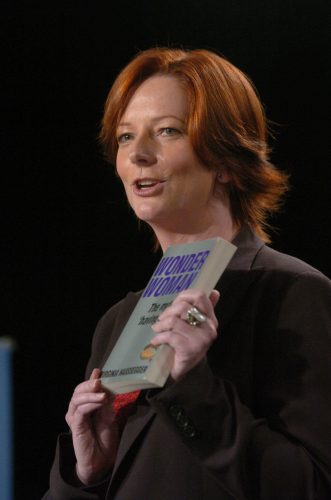China’s notion of ”calm” leaves me blue with cold.
Why does the Chinese Government think empty soulless streets, framed by steel barricades, and patrolled by faceless riot police and military tanks, is evidence of ”calm”? And yet that is what the official word from China was by late yesterday. The ”situation” in Lhasa was apparently ”calm”. Sporadic protest activity had spread across Tibet’s neighbouring three provinces, but that too was now mostly contained. And yes, police had engaged in some shooting in Sichuan province, but most of the towns in those recalcitrant regions were now locked down: effectively transforming them into ”armed encampments”, as the New York Times correspondent put it.
I strongly doubt those terrified Tibetans who haven’t yet been apprehended, incarcerated or voluntarily ”surrendered”, are feeling much ”calm” right now. Nor would the families of those who have been killed or injured during this week’s unrest.
Odd, isn’t it, how brutally oppressive regimes are so at ease in the presence of military paraphernalia. The more armoured tanks that roll in, and the bigger the barricades built to lock foreigners out, the greater is China’s sense of ”calm”. To flex such muscle, against a disorganised rabble fighting with sticks and stones, must elicit the most perverse form of ”calm” known to humanity. But then humanity doesn’t come into it. Not when the intention is to wipe out a race of people and obliterate their culture.
And to think that Australia condones this. As the Prime Minister rather awkwardly pointed out earlier this week, Australia recognises China’s sovereignty over Tibet. An uncomfortable matter, over which Australia has little choice, given our trade dependency on the resource- hungry behemoth. But don’t for a moment think Tibetans hold that against Australians. They don’t. Tibet long ago recognised it was but a tiny David in the face of a gargantuan Goliath, and agreed to accept China’s ownership of its territory after the failed 1959 uprising.
It took considerable guidance, but eventually the Tibetan Government in Exile embraced the Dalai Lama’s ”Middle-Way Policy”. It is a peaceful plan to restore stability to Tibet and enable coexistence with the Chinese. And as the spiritual leader has said repeatedly throughout this week, the Tibetan intention is not to achieve independence from China. It never has been. Rather, it is about restoring dignity to the Tibetans and allowing them autonomy in their homeland.
The struggle for independence was lost when the Dalai Lama was forced to flee to India, after some 87,000 of his countrymen were brutally slaughtered by the Chinese during the uprising. Since the occupation around 1.2 million Tibetans have died. Now with the massive immigration of Han Chinese into the area, and the forced relocation of many Tibetans into neighbouring provinces, there are more Chinese in Tibet than Tibetans. Although he was awarded a Nobel Peace Prize, is hailed by some as a God King and enjoys unprecedented international celebrity stardom, the Dalai Lama knows that not even he has the power to convince the likes of the United States, the United Kingdom, the European Union, or even Australia for that matter, to support Tibet in an armed conflict against China. It’s just never going to happen. Instead, the Middle Way has always been about ensuring Tibetans maintain a connection to their culture: to their language, traditions, beliefs and their Buddhist heritage. And it is clearly Tibetan Buddhism that confounds the Chinese the most.
Since invading Tibet back in 1951, China has tried desperately to shake, squeeze and smash the spirituality out of the people. But it seems not even the mass slaughter of monks and nuns could eradicate the people’s attachment to their Buddhist practices. When the exiled Dalai Lama chose a young Panchen Lama the second most important figure in Tibetan Buddhism the boy suddenly ”disappeared”. And so did his family. The Communist Party then declared it was the only one who had the authority and power to appoint Buddhist ”incarnations”. Accordingly China crowned its own ”true” Panchen Lama. Not surprisingly, the Dalai Lama now wants to break with tradition and choose his own reincarnation before he dies. It’s a bold move that may appear to flout some fundamental religious rituals, but who knows what kind of dangerous puppet the Chinese intend to put in the spiritual leader’s place, once he passes on.
Not long ago Tibet’s Communist Party Leader, Zhang Qingli, declared, ”The Central Party Committee is the real Buddha for Tibetans.” Which just goes to show how little understanding the Chinese have of the true nature of Tibetan Buddhism, despite over 50 years of occupation.
The Dalai Lama has lived through some unimaginably brutal times, but nothing must have been as painful as this. To watch what appears to be the final chapter of Tibet’s history, as the culture is crushed, its people dislocated, disorientated and finally silenced, may well hasten his departure from this world. Which is no doubt what the Chinese want. After all, Zhang Qingli declared war this week. ”We are currently in an intensely bloody and fiery struggle with the Dalai Lama clique, a life or death struggle with the enemy.” And time is running out. Those Olympic podiums are primed. The red carpet is ready. The Chinese welcome machine is well oiled. And Australians are queuing up to elbow through the grubby turnstiles.





